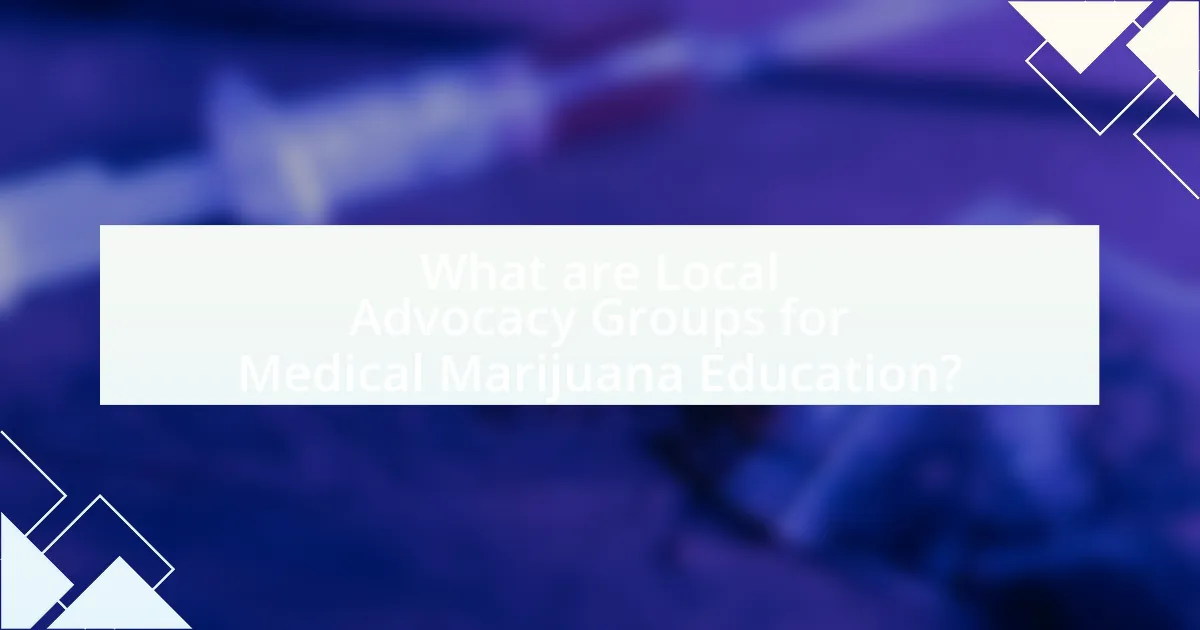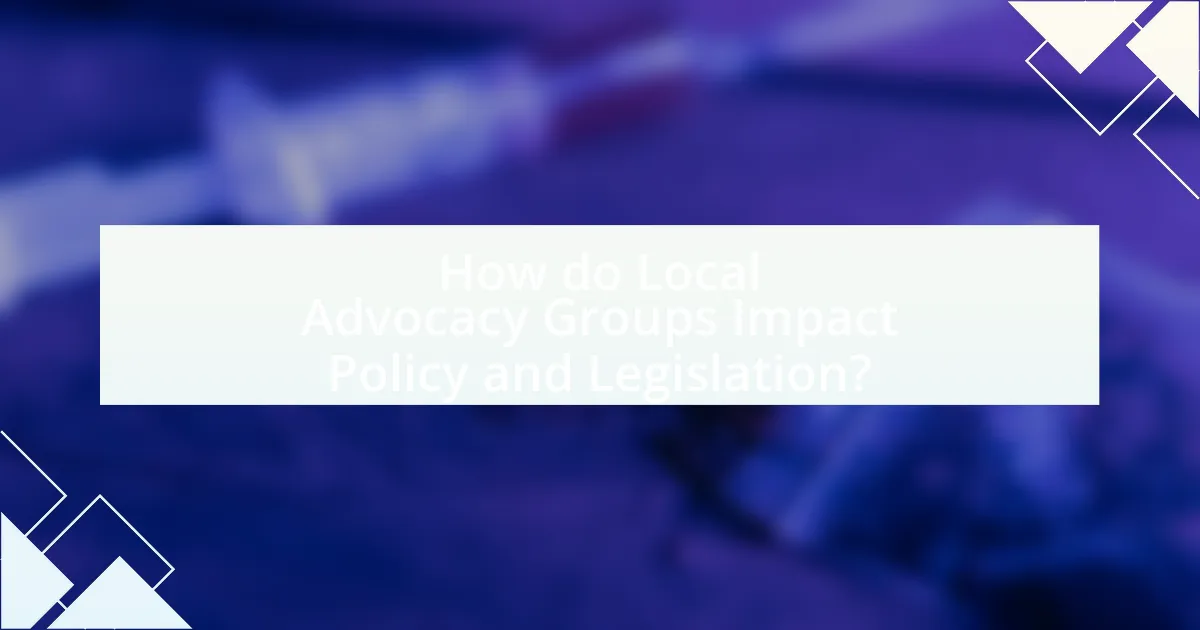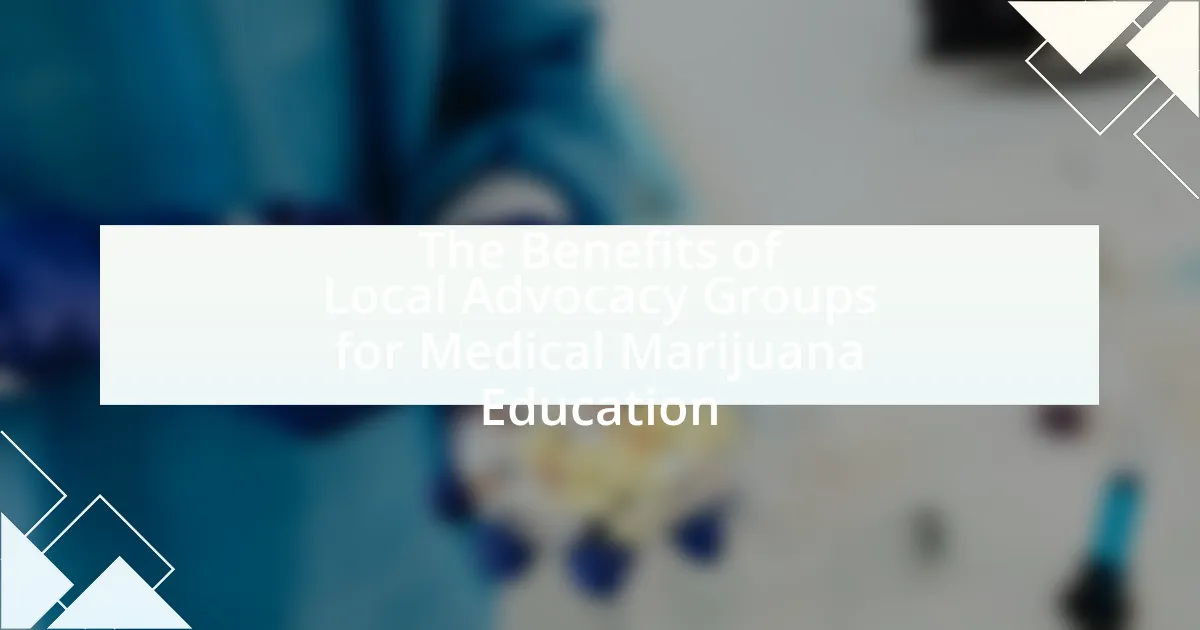Local advocacy groups for medical marijuana education play a vital role in informing and supporting communities about the use of medical cannabis. These organizations provide resources, conduct educational events, and advocate for policies that enhance access to medical marijuana. They function by organizing workshops, distributing materials, and collaborating with healthcare professionals to improve public understanding and acceptance of medical marijuana. Volunteers are essential in these efforts, helping to raise awareness and influence policy changes. Despite facing challenges such as limited funding and community resistance, these advocacy groups significantly impact legislation and foster community engagement, ultimately promoting informed decision-making regarding medical marijuana use.

What are Local Advocacy Groups for Medical Marijuana Education?
Local advocacy groups for medical marijuana education are organizations that aim to inform and support communities regarding the use of medical marijuana. These groups provide resources, conduct educational events, and advocate for policies that promote access to medical cannabis. For example, the National Organization for the Reform of Marijuana Laws (NORML) has local chapters that focus on educating the public about the benefits and legal aspects of medical marijuana. Such advocacy is crucial as it helps dispel myths, provides accurate information, and supports patients in navigating the medical marijuana landscape.
How do these groups function within the community?
Local advocacy groups for medical marijuana education function within the community by providing essential information, resources, and support to individuals seeking to understand the benefits and legalities of medical marijuana use. These groups organize educational workshops, distribute informational materials, and facilitate discussions that empower community members to make informed decisions regarding medical marijuana. For instance, a study by the National Organization for the Reform of Marijuana Laws (NORML) highlights that local advocacy groups significantly increase public awareness and acceptance of medical marijuana, leading to improved access for patients in need.
What roles do volunteers play in local advocacy groups?
Volunteers in local advocacy groups play crucial roles in organizing events, raising awareness, and mobilizing community support for medical marijuana education. They assist in outreach efforts by distributing informational materials, engaging with community members, and facilitating discussions to educate the public about the benefits and legal aspects of medical marijuana. Additionally, volunteers often participate in lobbying efforts, helping to influence policy decisions by connecting with local lawmakers and advocating for patient rights. Their involvement is essential for building a grassroots movement, as evidenced by studies showing that community-driven initiatives significantly enhance public understanding and acceptance of medical marijuana policies.
How do advocacy groups collaborate with healthcare professionals?
Advocacy groups collaborate with healthcare professionals by engaging in joint educational initiatives, sharing research, and promoting policy changes that support medical marijuana use. These collaborations often involve organizing workshops and seminars where healthcare professionals can learn about the benefits and applications of medical marijuana, thereby enhancing their understanding and ability to recommend it to patients. For instance, a study published in the Journal of Cannabis Research highlights that advocacy groups have successfully partnered with medical associations to develop guidelines that inform practitioners about the therapeutic uses of cannabis, ensuring that healthcare providers are equipped with accurate and up-to-date information.
Why is medical marijuana education important?
Medical marijuana education is important because it equips patients, healthcare providers, and the public with essential knowledge about its therapeutic benefits and risks. Understanding the medical applications of marijuana can lead to informed decision-making regarding treatment options for conditions such as chronic pain, epilepsy, and multiple sclerosis. Research indicates that education can improve patient outcomes; for instance, a study published in the Journal of Pain Research found that patients who received education about medical marijuana reported better pain management and quality of life. Furthermore, education helps dispel myths and stigma surrounding medical marijuana, fostering a more supportive environment for patients seeking alternative therapies.
What misconceptions exist about medical marijuana?
Misconceptions about medical marijuana include the belief that it is simply a cover for recreational use and that it lacks any legitimate medical benefits. Many people assume that medical marijuana is not scientifically validated, despite numerous studies indicating its efficacy in treating conditions such as chronic pain, epilepsy, and multiple sclerosis. For instance, a review published in the Journal of the American Medical Association found that cannabinoids can significantly reduce chronic pain in adults. Additionally, some individuals think that medical marijuana is addictive, while research from the National Institute on Drug Abuse shows that the risk of developing a cannabis use disorder is lower than that associated with many prescription medications. These misconceptions hinder the acceptance and understanding of medical marijuana’s potential benefits.
How can education help in reducing stigma around medical marijuana?
Education can significantly reduce stigma around medical marijuana by providing accurate information about its benefits and uses. When individuals are educated about the therapeutic effects of medical marijuana, such as its efficacy in managing chronic pain and alleviating symptoms of conditions like epilepsy and multiple sclerosis, misconceptions can be challenged. Research from the National Academies of Sciences, Engineering, and Medicine indicates that there is substantial evidence supporting the effectiveness of medical marijuana for certain medical conditions, which can help shift public perception. Furthermore, educational initiatives led by local advocacy groups can foster open discussions, dispel myths, and promote understanding, ultimately leading to a more informed and accepting community regarding medical marijuana use.
What specific benefits do local advocacy groups provide?
Local advocacy groups provide essential benefits such as education, community support, and policy influence regarding medical marijuana. These groups educate the public about the therapeutic uses and legal aspects of medical marijuana, helping to dispel myths and misinformation. They also foster community support by connecting patients, caregivers, and advocates, creating a network that shares resources and experiences. Furthermore, local advocacy groups influence policy by lobbying for legislation that supports medical marijuana access and patient rights, as evidenced by successful campaigns in various states that have led to the legalization and regulation of medical marijuana programs.
How do these groups enhance community awareness about medical marijuana?
Local advocacy groups enhance community awareness about medical marijuana through educational campaigns, workshops, and outreach programs. These initiatives provide accurate information about the benefits and uses of medical marijuana, addressing misconceptions and stigma. For instance, studies show that communities engaged in educational outreach report increased understanding of medical marijuana’s therapeutic effects, leading to greater acceptance and informed discussions among residents.
What resources do advocacy groups offer to patients and caregivers?
Advocacy groups offer a variety of resources to patients and caregivers, including educational materials, support networks, and access to legal assistance. These groups provide information on medical marijuana laws, usage guidelines, and potential benefits, helping patients make informed decisions about their treatment options. Additionally, they often facilitate connections with healthcare professionals and other patients, fostering a community of support. Legal assistance is also available to navigate the complexities of medical marijuana regulations, ensuring that patients and caregivers understand their rights and responsibilities.

How do Local Advocacy Groups Impact Policy and Legislation?
Local advocacy groups significantly impact policy and legislation by mobilizing community support, influencing public opinion, and directly engaging with lawmakers. These groups often conduct research, disseminate information, and organize campaigns that highlight the benefits and needs related to medical marijuana, thereby shaping legislative agendas. For instance, the National Organization for the Reform of Marijuana Laws (NORML) has successfully lobbied for the legalization of medical marijuana in multiple states, demonstrating how grassroots efforts can lead to substantial policy changes. Their advocacy efforts have resulted in over 30 states legalizing medical marijuana, showcasing the effectiveness of local groups in driving legislative reform.
What role do advocacy groups play in shaping medical marijuana laws?
Advocacy groups play a crucial role in shaping medical marijuana laws by mobilizing public support, influencing policymakers, and providing education on the benefits and risks of medical cannabis. These organizations often conduct research, gather data, and share personal stories that highlight the therapeutic potential of medical marijuana, which can sway legislative decisions. For instance, in states like California, advocacy groups successfully campaigned for Proposition 215 in 1996, making it the first state to legalize medical marijuana, demonstrating their significant impact on law formation.
How do these groups influence local government decisions?
Local advocacy groups for medical marijuana influence local government decisions by mobilizing community support, providing educational resources, and lobbying for policy changes. These groups often organize campaigns that raise awareness about the benefits of medical marijuana, which can shift public opinion and pressure local officials to consider legislation that supports its use. For instance, in states where advocacy groups have been active, such as California, local governments have seen increased public support for medical marijuana initiatives, leading to the adoption of more favorable regulations. Additionally, these groups frequently engage in direct lobbying efforts, presenting research and testimonials that highlight the medical benefits of marijuana, thereby influencing policymakers to align their decisions with community interests and health needs.
What strategies do advocacy groups use to lobby for policy changes?
Advocacy groups employ various strategies to lobby for policy changes, including grassroots mobilization, coalition building, direct lobbying, and public awareness campaigns. Grassroots mobilization involves engaging community members to participate in advocacy efforts, which can amplify their voices and demonstrate widespread support for specific policies. Coalition building allows advocacy groups to unite with other organizations, increasing their influence and resources. Direct lobbying involves meeting with lawmakers and their staff to present research, data, and personal stories that highlight the need for policy changes. Public awareness campaigns utilize media and social platforms to educate the public and policymakers about the benefits of medical marijuana, thereby creating a favorable environment for legislative change. These strategies have been effective in influencing policy decisions, as evidenced by the increasing number of states legalizing medical marijuana, reflecting the impact of organized advocacy efforts.
How can local advocacy groups foster community engagement?
Local advocacy groups can foster community engagement by organizing educational events and workshops that inform the public about medical marijuana. These events create opportunities for community members to learn about the benefits, regulations, and safe usage of medical marijuana, thereby increasing awareness and understanding. For instance, a study by the National Institute on Drug Abuse highlights that community education initiatives can significantly improve public knowledge and attitudes towards medical marijuana, leading to greater acceptance and support for its use. Additionally, advocacy groups can facilitate discussions and forums that encourage community members to voice their concerns and share experiences, further enhancing engagement and building a supportive network.
What events do advocacy groups organize to promote education?
Advocacy groups organize various events such as workshops, seminars, and community forums to promote education. These events aim to raise awareness about medical marijuana, its benefits, and responsible usage. For instance, workshops often feature expert speakers who provide evidence-based information, while community forums encourage open discussions among stakeholders, including patients, healthcare providers, and policymakers. These organized events are crucial for disseminating accurate information and fostering informed dialogue, ultimately contributing to better understanding and acceptance of medical marijuana in communities.
How do advocacy groups encourage public participation in discussions about medical marijuana?
Advocacy groups encourage public participation in discussions about medical marijuana by organizing community events, providing educational resources, and facilitating open forums for dialogue. These groups often host workshops, town hall meetings, and informational sessions that invite community members to learn about the benefits and regulations surrounding medical marijuana. For instance, the National Organization for the Reform of Marijuana Laws (NORML) frequently conducts outreach programs that engage citizens in discussions about policy changes and personal experiences with medical marijuana. Additionally, advocacy groups utilize social media platforms to disseminate information and mobilize supporters, thereby increasing public awareness and involvement in legislative processes related to medical marijuana.

What Challenges Do Local Advocacy Groups Face?
Local advocacy groups face several challenges, including limited funding, regulatory hurdles, and community resistance. Limited funding restricts their ability to conduct outreach and educational programs, which are essential for raising awareness about medical marijuana. Regulatory hurdles often complicate their efforts to advocate for policy changes, as they must navigate complex legal frameworks that can vary significantly by region. Additionally, community resistance can arise from misinformation or stigma surrounding medical marijuana, making it difficult for these groups to gain support and effectively communicate their message. These challenges hinder the overall impact and effectiveness of local advocacy efforts in promoting medical marijuana education.
What obstacles hinder the effectiveness of advocacy groups?
Advocacy groups face several obstacles that hinder their effectiveness, including limited funding, lack of public awareness, and political opposition. Limited funding restricts their ability to conduct outreach, research, and advocacy efforts, which is critical for raising awareness about medical marijuana education. For instance, a study by the National Council of Nonprofits indicates that 70% of nonprofits report funding as a significant barrier to achieving their missions. Additionally, lack of public awareness about the benefits and legality of medical marijuana can lead to insufficient support for advocacy initiatives. Political opposition, often stemming from outdated perceptions of marijuana, can further complicate efforts, as seen in various states where legislation for medical marijuana has faced significant hurdles despite public support. These factors collectively diminish the impact and reach of advocacy groups focused on medical marijuana education.
How do funding issues affect local advocacy efforts?
Funding issues significantly hinder local advocacy efforts by limiting resources necessary for outreach, education, and mobilization. When local advocacy groups face financial constraints, they struggle to conduct community workshops, distribute educational materials, and engage in effective lobbying activities. For instance, a study by the National Council of Nonprofits indicates that 70% of nonprofits report that funding challenges directly impact their ability to fulfill their missions. This lack of funding can lead to reduced visibility and influence in policy discussions, ultimately undermining the effectiveness of advocacy for medical marijuana education.
What legal challenges do advocacy groups encounter?
Advocacy groups encounter legal challenges such as restrictions on fundraising, compliance with lobbying regulations, and potential litigation from opposing entities. These challenges arise because advocacy groups often operate in a complex legal environment where laws governing political contributions and lobbying activities can vary significantly by jurisdiction. For instance, in the context of medical marijuana education, advocacy groups may face legal scrutiny regarding their ability to promote policy changes or educate the public, especially in states where marijuana laws are still evolving. Additionally, they may encounter lawsuits aimed at silencing their efforts or challenging their legitimacy, which can hinder their operations and limit their effectiveness in advocating for medical marijuana initiatives.
How can advocacy groups overcome these challenges?
Advocacy groups can overcome challenges by building strong coalitions with other organizations and stakeholders to amplify their voice and resources. Collaborating with local health professionals, legal experts, and community leaders can enhance credibility and outreach, as evidenced by successful campaigns in states like California, where coalitions have effectively influenced public policy and education regarding medical marijuana. Additionally, utilizing data-driven approaches to demonstrate the benefits of medical marijuana can help counteract misinformation and stigma, as seen in studies published by the National Academies of Sciences, Engineering, and Medicine, which provide evidence of its therapeutic effects.
What best practices can enhance the effectiveness of advocacy groups?
Effective advocacy groups can enhance their impact by employing strategies such as building strong coalitions, utilizing data-driven messaging, and engaging in grassroots mobilization. Strong coalitions allow advocacy groups to pool resources and amplify their voices, as seen in successful campaigns like the American Cancer Society’s collaboration with various health organizations to promote cancer awareness. Data-driven messaging ensures that the information presented is credible and persuasive; for instance, studies show that campaigns backed by statistics are 50% more likely to influence public opinion. Grassroots mobilization fosters community involvement and support, which has proven effective in initiatives like the legalization of medical marijuana in several states, where local advocacy played a crucial role in shaping public policy.
How can collaboration with other organizations strengthen advocacy efforts?
Collaboration with other organizations can significantly strengthen advocacy efforts by pooling resources, expertise, and networks to amplify the message and reach a broader audience. When local advocacy groups for medical marijuana education partner with established organizations, they can leverage shared knowledge and strategies that enhance credibility and effectiveness. For instance, a study by the National Institute on Drug Abuse highlights that collaborative efforts can lead to increased public awareness and support, as seen in successful campaigns that united various stakeholders in the medical marijuana sector. This synergy not only fosters a more unified front but also enables the sharing of best practices, ultimately leading to more impactful advocacy outcomes.
What are the best practices for engaging with local advocacy groups?
The best practices for engaging with local advocacy groups include establishing clear communication, building trust, and collaborating on shared goals. Clear communication ensures that both parties understand each other’s objectives and concerns, which is essential for effective partnership. Building trust involves being transparent about intentions and consistently following through on commitments, fostering a positive relationship. Collaboration on shared goals, such as promoting medical marijuana education, allows for pooling resources and expertise, enhancing the impact of advocacy efforts. Research indicates that organizations that engage in collaborative advocacy are more successful in achieving their objectives, as demonstrated by the increased awareness and acceptance of medical marijuana initiatives in communities where local advocacy groups actively participate.

Leave a Reply